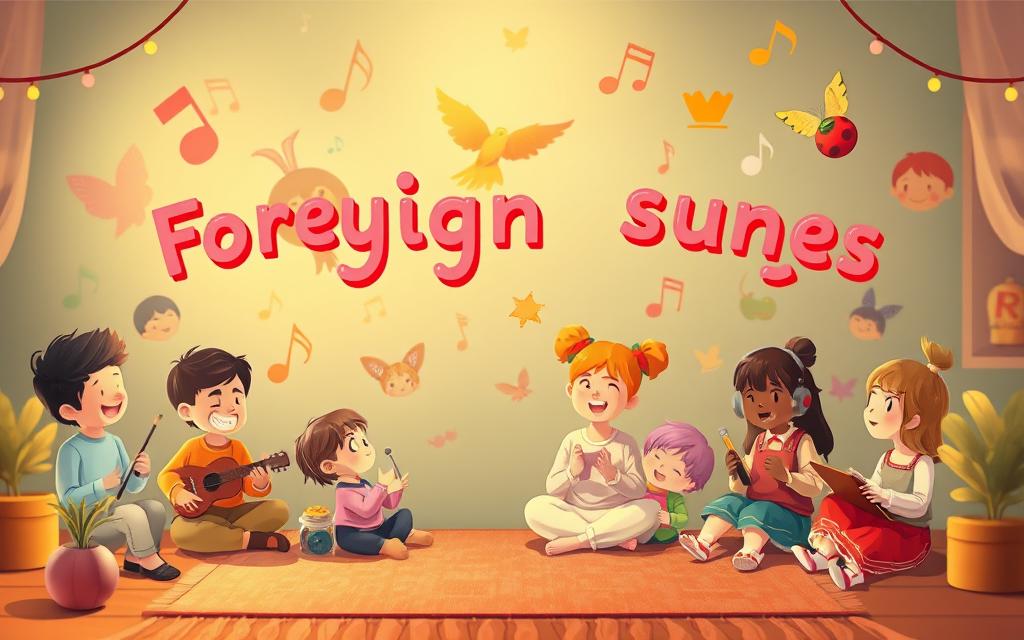Did you know music can activate three brain centers? These are language, hearing, and rhythmic motor control. This makes music a great tool for learning languages. By using foreign language songs, you can make learning fun and interactive.
Using bilingual songs in a multicultural classroom boosts language skills and cultural awareness. This is a big plus for kids.
Exploring foreign language songs for teaching children shows many benefits. Music helps with vocabulary and pronunciation. It’s a key part of language development.
In a multicultural classroom, bilingual songs make learning fun and inclusive. They promote language and cultural awareness.
Why Music Is Your Best Ally in Language Teaching
Music is a great tool for teaching languages. Studies show it can boost learning by up to 70%. This is because music works with three brain areas at once: language, hearing, and rhythm.
By using foreign language songs for teaching children, you can make learning more complete. It helps with school, social, and emotional growth.
Research found kids who learned with music did 20% better on vocabulary tests. About 85% of teachers say kids language learning songs make lessons more engaging. Music makes learning fun and interactive, which is key for kids.
- Improved retention rates
- Increased student engagement and motivation
- Enhanced cognitive skills, such as memory and attention
- Improved emotional intelligence and social skills
Using world music for young learners in your lessons can make learning fun. It helps with language skills and cultural understanding.
Best Foreign Language Songs for Teaching Children by Age Group
Teaching children foreign language songs is a fantastic way to introduce them to new cultures, improve pronunciation, and make language learning fun. The best songs vary by age group, as younger children need simpler lyrics and catchy melodies, while older kids can handle more complex vocabulary and themes. Below is a well-structured guide to the best foreign language songs for teaching children, categorized by age group.
1. Toddlers & Preschoolers (Ages 2–5)
At this stage, songs should be:
- Simple & repetitive (easy to mimic)
- Interactive (with actions or movements)
- Melodic & rhythmic (to capture attention)
Recommended Songs:
Spanish:
- “Los Pollitos Dicen” (Traditional) – Teaches animal sounds and basic verbs.
- “Debajo un Botón” (Traditional) – A playful song with simple vocabulary.
French:
- “Frère Jacques” (Traditional) – A classic round with repetitive lyrics.
- “Alouette” (Traditional) – Introduces body parts in a fun way.
Mandarin Chinese:
- “两只老虎” (Liǎng Zhī Lǎohǔ, “Two Tigers”) – A catchy tune similar to “Frère Jacques.”
- “找朋友” (Zhǎo Péngyou, “Looking for a Friend”) – Encourages interaction.
Japanese:
- “あたま、かた、ひざ、ぽん” (Atama, Kata, Hiza, Pon, “Head, Shoulders, Knees, and Toes”) – Teaches body parts.
- “ぞうさん” (Zou-san, “Elephant Song”) – Simple and sweet.
German:
- “Häschen in der Grube” (Traditional) – A playful bunny song.
- “Backe, backe Kuchen” – Introduces baking vocabulary.
2. Early Elementary (Ages 6–8)
Children in this group can handle:
- Slightly longer lyrics
- Basic storytelling in songs
- Cultural themes
Recommended Songs:
Spanish:
- “La Bamba” (Mexican Folk Song) – Upbeat and introduces verbs.
- “El Coquí” (Puerto Rican Folk Song) – Teaches about nature.
French:
- “Sur le Pont d’Avignon” – A dance song with historical context.
- “Petit Papa Noël” (Christmas song) – Seasonal vocabulary.
Italian:
- “Volare” (Nel Blu Dipinto Di Blu) – Domenico Modugno – A joyful classic.
- “Giro Giro Tondo” – A circle game song.
Korean:
- “산할아버지” (San Halabeoji, “Mountain Grandfather”) – Folk song with nature themes.
- “곰 세 마리” (Gom Se Mari, “Three Bears”) – A playful tune.
Hindi:
- “Lakdi Ki Kathi” (From Bollywood’s Masoom) – A fun, rhythmic song.
3. Upper Elementary (Ages 9–12)
Older children can explore:
- More complex lyrics
- Cultural/historical significance
- Popular music (age-appropriate)
Recommended Songs:
Spanish:
- “Cielito Lindo” (Mexican Folk Song) – Cultural heritage.
- “Vivir Mi Vida” – Marc Anthony (Upbeat, positive message).
French:
- “Aux Champs-Élysées” – Joe Dassin (Great for vocabulary).
- “On écrit sur les murs” – Kids United (Modern, meaningful).
Japanese:
- “ドラえもんの歌” (Doraemon no Uta, “Doraemon Theme Song”) – Fun pop culture tie-in.
- “世界に一つだけの花” (Sekai ni Hitotsu Dake no Hana) – SMAP – Positive message.
German:
- “99 Luftballons” – Nena (Cold War history + catchy tune).
Swahili:
- “Jambo Bwana” (Kenyan Pop Song) – A cheerful introduction to Swahili.
Tips for Teaching Foreign Songs to Kids:
- Use visuals (videos, flashcards) to reinforce meaning.
- Incorporate movements/dances to aid memory.
- Discuss cultural context (e.g., where the song comes from).
- Sing along gradually (start with choruses, then verses).
- Make it fun! (karaoke, competitions, or puppet shows).
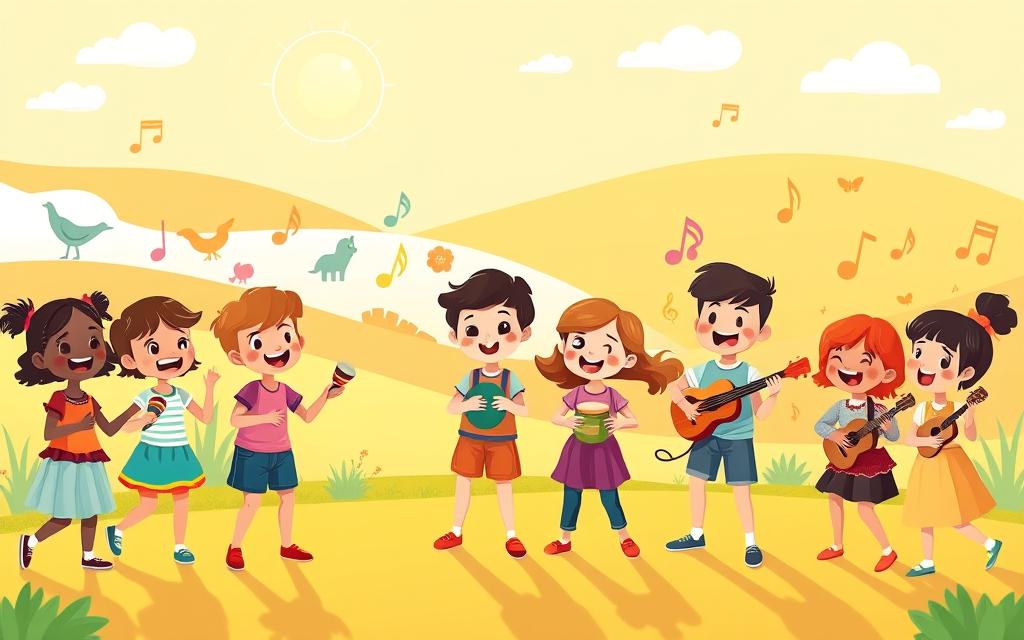
Teaching kids a new language can be fun with children’s songs for language acquisition. These songs help kids learn new words and sounds in a fun way. For little ones, songs like “The Wheels on the Bus” are great. Older kids can enjoy songs like “La Cucaracha” that teach more.
Fun language songs for kids make learning a positive experience. They can teach Spanish, French, and German. International tunes for language education also help kids appreciate different cultures. Teachers and parents can use these songs to make language learning exciting.
Some top children’s songs for language acquisition are alphabet songs like “The Alphabet Song”. These songs help kids learn the alphabet and sounds. Songs like “The Wheels on the Bus” and “Old MacDonald Had a Farm” also teach new words and improve language skills.
Popular Spanish Songs That Make Learning Fun
Teaching kids a new language can be fun with foreign language songs for teaching children. In a multicultural music classroom, bilingual songs for kids make learning interactive. For instance, “Los pollitos dicen” is a hit with kids and helps them learn.
Modern Spanish children’s songs also teach vocabulary and grammar. You can find these on YouTube and Spotify. Artists like Matisse, Christian Nodal, and Alejandro Sanz offer a variety of music for different tastes.
Music can greatly improve language learning. Studies show kids who learn through music do better. Music makes learning fun and keeps kids motivated to learn more.
Some great resources for teaching Spanish to kids include:
- Toobys Español
- Toy Cantando
- CantaJuego
These tools offer songs and activities for teaching vocabulary, grammar, and pronunciation. By using bilingual songs for kids and foreign language songs for teaching children, you can make your classroom engaging and effective.
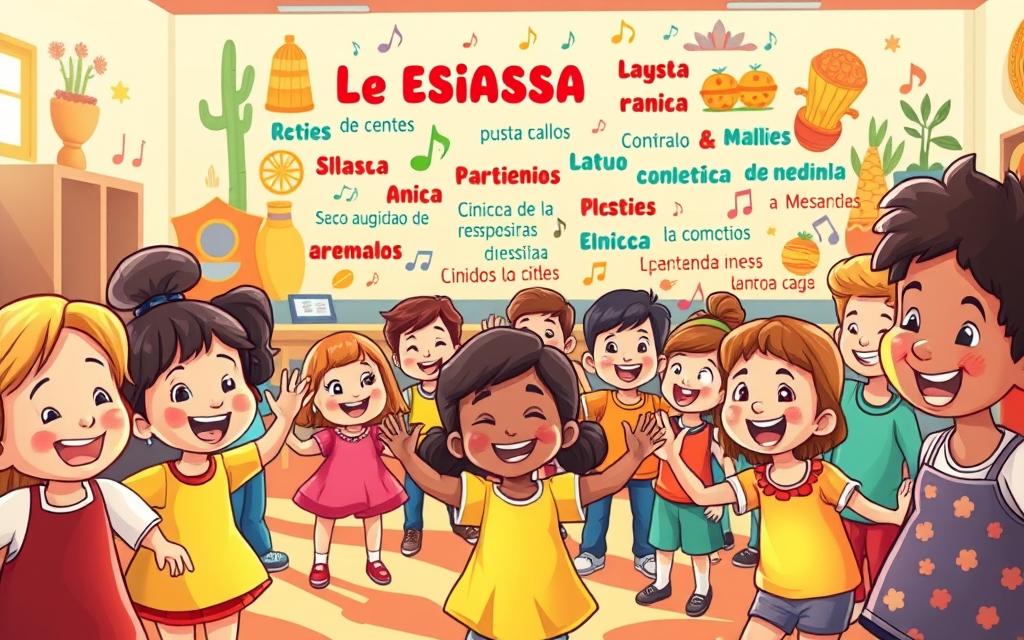
French Language Songs Your Kids Will Love
Teaching kids a new language can be fun with world music for young learners. French songs are great for this. They help kids learn the French alphabet and improve their speaking skills. For instance, “The Alphabet Song” in French is perfect for introducing the language.
“Frere Jacques” is another great song for teaching vocabulary and grammar. It makes learning French fun and engaging.
Using educational children’s songs in different languages makes learning interactive. French songs like “La Vie En Rose” and “Alouette” teach rhythm and movement. These songs can also make lessons fun with singing, dancing, and crafts.
French songs help kids learn new words and grammar. For example, singing “Frere Jacques” and acting out the lyrics is a great way to practice. It’s fun and educational.
These songs also teach kids about different cultures. You can teach them about French traditions, like singing “La Marseillaise” on special days.

French language songs are a great tool for teaching kids. By using world music for young learners and educational children’s songs in different languages, you can make learning fun. This helps kids develop a love for the language and culture.
Essential German Songs for Young Learners
Music is a great tool for teaching kids a new language. German songs can help young learners grow their language skills and learn about different cultures. By using foreign language songs for teaching children in your lessons, you make learning fun and engaging.
In a multicultural music classroom, kids can discover various music styles, including traditional and modern German songs. This helps them appreciate the diversity of German culture and language. Songs like “Ein Mann, Ein Wort” and “Weihnachtslieder” can teach vocabulary and grammar while encouraging bilingual songs for kids and language exchange.
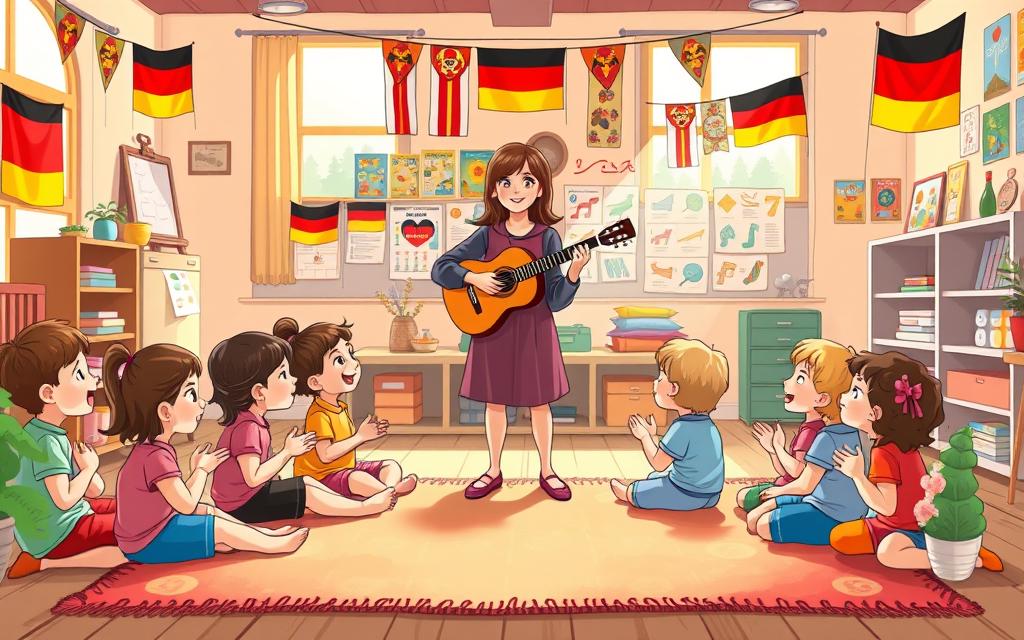
“The Alphabet Song” in German is great for teaching the German alphabet and phonemic awareness. Songs like “Wer, Wie, Was” and “Du hast” introduce essential German vocabulary and grammar. These songs make learning a new language fun and comprehensive.
Using German songs in your lessons helps students improve their language skills and cultural awareness. It also fosters appreciation for bilingual songs for kids. With the right approach, you can make learning a new language fun and engaging, making foreign language songs for teaching children a key part of your teaching.
Create a Multicultural Music Environment
Creating a multicultural music classroom is a great way to make learning fun and inclusive. By using songs in different languages, you help students appreciate diverse cultures. It also makes learning languages more engaging.
Students can learn about different cultures by trying out traditional instruments and wearing costumes. Songs from around the world can teach them new words, grammar, and how to pronounce them. For example, Japanese songs can introduce Japanese culture, while Mexican songs can teach about Mexican heritage.
Here are some ways to make your classroom more multicultural:
- Play songs in different languages to help students learn new languages.
- Use traditional instruments and costumes to make learning more immersive.
- Include songs in your lessons to help students learn languages.
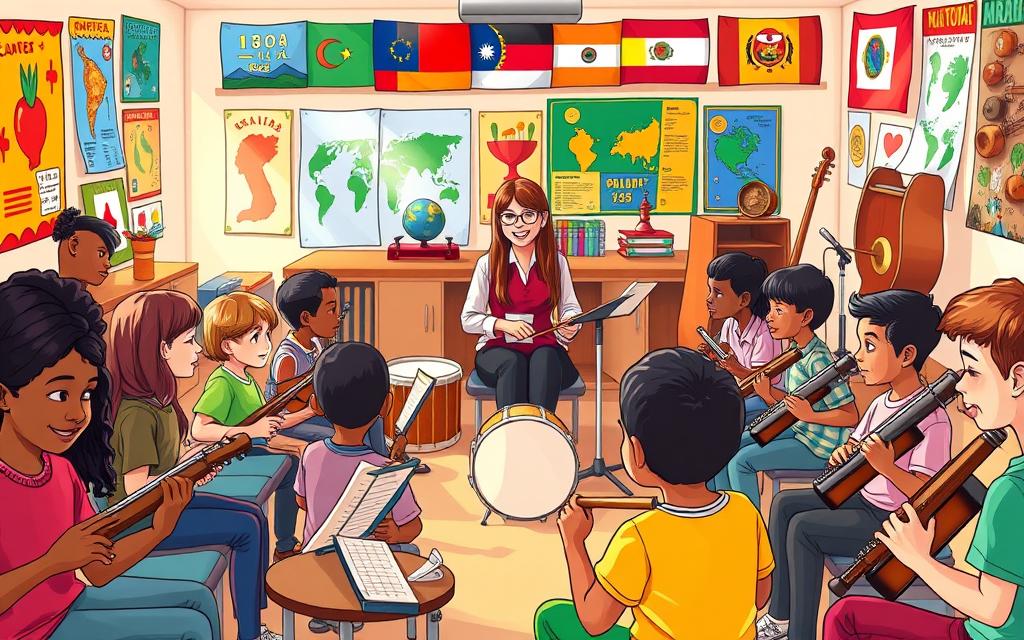
Creating a multicultural music classroom helps students understand and appreciate different cultures. It prepares them to be global citizens who value diversity. So, start exploring multicultural music and see how it can enrich your students’ language learning!
Use Technology to Enhance Musical Language Learning
Technology is key in language learning, especially when mixed with music. It makes learning fun for kids. Fun language songs for kids help them learn while enjoying songs from around the world. Online tools and apps have lots of songs for kids to learn languages, helping teachers and parents make learning fun and effective.
Using technology to enhance musical language learning can make the process more engaging, interactive, and effective for children. Digital tools provide multimedia experiences that reinforce vocabulary, pronunciation, and cultural context while keeping kids motivated. Below is a detailed discussion on how to integrate technology effectively.
1. Streaming Platforms & YouTube
Benefits:
- Access to a vast library of foreign-language songs.
- Visual aids (lyric videos, animations) reinforce comprehension.
- Exposure to authentic accents and cultural elements.
How to Use:
- YouTube Channels:
- Super Simple Español / Français (Animated songs for young learners).
- Canticos (Bilingual Spanish-English songs).
- Spotify/Apple Music Playlists:
- Curate playlists by language/theme (e.g., “French Animal Songs”).
Example Activity:
- Watch a lyric video (e.g., “Head, Shoulders, Knees and Toes” in Mandarin), then pause to practice words.
2. Language Learning Apps with Music
Recommended Apps:
- Duolingo Kids (Gamified lessons with songs).
- Lingokids (Interactive music-based activities).
- DinoLingo (Animated songs in 50+ languages).
Features to Leverage:
- Karaoke-style sing-alongs.
- Pronunciation feedback via AI.
- Quizzes tied to song lyrics.
3. Interactive Whiteboards & Smartboards
Classroom Applications:
- Display lyrics with clickable translations.
- Annotate songs with grammar/vocabulary notes.
- Collaborative activities (e.g., drag-and-drop matching games with song vocabulary).
Tool Example:
- Nearpod (Create interactive lessons around songs).
4. Digital Flashcards & Lyrics Tools
Tools:
- Quizlet (Create flashcards from song vocabulary).
- LyricsTraining (Fill-in-the-blank exercises with music videos).
Activity Idea:
- After listening to “Alouette,” use Quizlet to drill body parts in French.
5. Virtual Reality (VR) & Cultural Immersion
Innovative Approach:
- Use VR platforms like YouTube 360° to “visit” a Spanish flamenco performance or a Japanese festival while learning related songs.
Example:
- Pair “Cielito Lindo” with a VR tour of Mexico.
6. Recording & Performance Apps
Why It Works:
- Kids gain confidence by recording themselves singing.
- Peer feedback builds community.
Apps/Tools:
- GarageBand (Create multilingual song projects).
- Flipgrid (Share video covers of foreign songs).
Activity:
- Host a virtual “Eurovision” where students perform songs in target languages.
7. AI-Powered Tools
Cutting-Edge Options:
- ChatGPT (Generate simple songs or translate lyrics).
- ELSA Speak (AI pronunciation coach for singing).
Example Prompt for AI:
“Write a short Spanish song about animals for a 6-year-old to the tune of ‘Twinkle Twinkle Little Star.'”
8. Online Collaboration Platforms
Global Connections:
- eTwinning or PenPal Schools to pair classrooms for music exchanges.
- Google Jamboard to co-write lyrics with partner schools abroad.
Project Idea:
- Co-create a multilingual song with a sister school.
Best Practices for Tech Integration
- Scaffold Learning: Start with listening, then progress to singing/creating.
- Mix Media: Combine apps, videos, and live interaction.
- Monitor Screen Time: Balance tech with offline activities (e.g., crafting instruments).
- Assess Progress: Use apps like Seesaw to track language milestones.
Example Tech-Enhanced Lesson Plan
Song: “Frère Jacques” (French)
- Listen to the song on YouTube with animated lyrics.
- Play a LyricsTraining game to fill in missing words.
- Record student versions using Flipgrid.
- Extend with a VR tour of a French monastery (tying into the song’s origins).
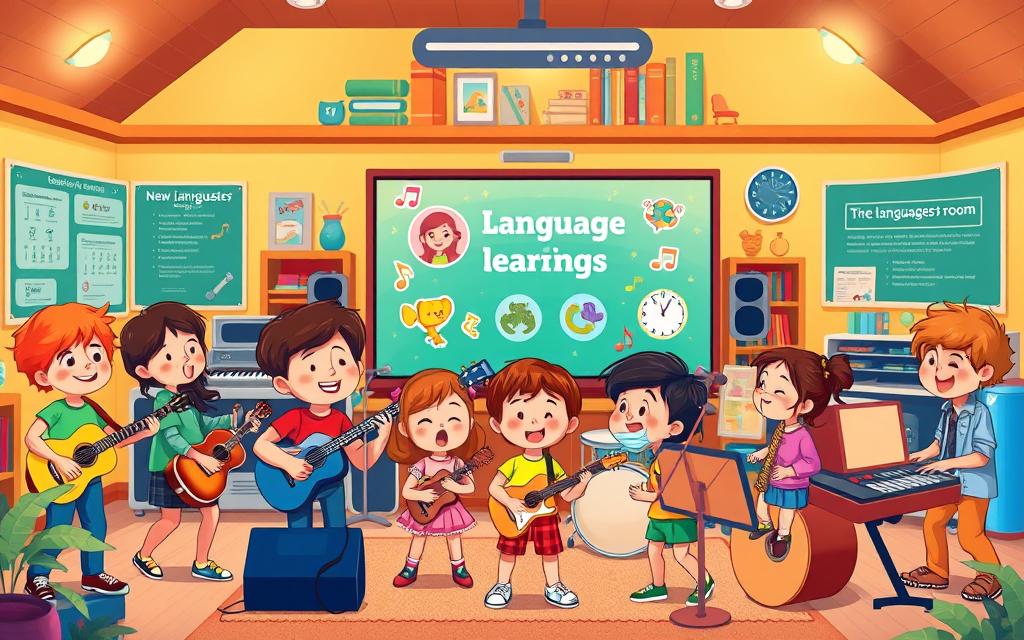
Technology also lets us make interactive music tools for learning. For example, GarageBand and Logic can help create special children’s songs for language acquisition. Using tech in music learning makes it more engaging and prepares kids for a global world.
Teaching Techniques Through Song and Dance
Integrating song and dance into language education is a powerful multisensory strategy that enhances memory, engagement, and cultural understanding. This approach aligns with Total Physical Response (TPR), Kinaesthetic Learning Theory, and Communicative Language Teaching (CLT). Below is a well-structured discussion on effective techniques, benefits, and practical applications.
1. Why Song & Dance Work in Language Teaching
Cognitive Benefits
- Memory Retention: Melodies and rhythms help encode vocabulary in long-term memory (the “Mozart Effect”).
- Pattern Recognition: Repetitive lyrics reinforce grammar structures naturally.
- Phonemic Awareness: Songs improve pronunciation and intonation.
Social-Emotional Benefits
- Reduces Anxiety: Playful learning lowers the “affective filter” (Krashen’s theory).
- Encourages Participation: Shy students engage more through movement.
- Builds Classroom Community: Group singing/dancing fosters teamwork.
Cultural Benefits
- Introduces traditions, gestures, and context (e.g., flamenco for Spanish, Bon Odori for Japanese).
2. Key Teaching Techniques
A. Total Physical Response (TPR) + Song
- How it works: Pair lyrics with actions (e.g., “Head, Shoulders, Knees and Toes” in Mandarin).
- Example: Teach French verbs by acting out “Je saute, je cours, je danse” (I jump, I run, I dance).
B. Call-and-Response Songs
- How it works: Teacher sings a line, students echo (e.g., African folk songs, Latin American “Canto, canto, canto”).
- Example:
- Teacher: “¿Cómo te llamas?”
- Students: “Me llamo [Name]!”
C. Narrative Storytelling Through Song
- How it works: Use songs with clear stories (e.g., “La Cucaracha” for Spanish, “Momotaro” in Japanese).
- Extension: Have students act out the plot.
D. Dance Routines for Grammar & Vocabulary
- How it works: Assign movements to words (e.g., jump for “high,” crouch for “low”).
- Example: Teach prepositions with “The Hokey Pokey” in German (“Rein, raus, rein, raus!” = In, out, in, out!).
E. Songwriting & Adaptation
- How it works: Rewrite familiar tunes (e.g., “Happy Birthday” with target-language vocabulary).
- Example:
- Original: “Twinkle, twinkle, little star”
- Spanish: “Brilla, brilla, estrellita” (add new verses about colors/numbers).
3. Age-Specific Strategies
Toddlers & Preschoolers (Ages 2–5)
- Focus: Simple, repetitive songs with motions (e.g., “Los Pollitos Dicen” + flapping arms like chicks).
- Tool: Puppets or props (e.g., a stuffed bear for “Ours Brun, Dis-Moi”).
Early Elementary (Ages 6–9)
- Focus: Thematic songs (weather, animals) + circle dances (e.g., “Ring Around the Rosie” in French).
- Tool: Interactive whiteboards to highlight lyrics.
Older Children (Ages 10–12)
- Focus: Pop songs with cultural depth (e.g., “Despacito” for Spanish subjunctive, “Sukiyaki” for Japanese history).
- Tool: LyricsTraining.com for fill-in-the-blank challenges.
4. Practical Classroom Activities
Activity 1: “Musical Chairs” (Listening Comprehension)
- Play a foreign song; when music stops, students answer a question about the lyrics.
Activity 2: “Dance-Freeze” (Vocabulary Drill)
- Students dance to “Baila Baila” (Spanish) or “Dansez maintenant!” (French); when music pauses, they shout out a vocabulary word.
Activity 3: “Song Bingo”
- Create bingo cards with vocabulary from a song; students mark words as they hear them.
Activity 4: “Cultural Dance-Along”
- Learn a traditional dance (e.g., Greek “Zorba”, Brazilian “Samba”) while singing lyrics.
5. Overcoming Challenges
| Challenge | Solution |
|---|---|
| Students resist singing | Start with instrumental versions or humming. |
| Limited language proficiency | Use songs with lots of repetition (e.g., “Tingo Tango” for Spanish). |
| Cultural unfamiliarity | Pair songs with videos/documentaries. |
6. Tech Integration (Enhancing Song & Dance)
- Karaoke Apps (Smule, YouTube karaoke tracks).
- VR Field Trips (Explore Carnival in Rio while learning Portuguese songs).
- Green Screen Videos (Students perform against cultural backdrops).
Using songs and dances in language lessons can really grab young learners’ attention. It makes learning fun and helps them remember important language skills. Music, movement, and language together create a lively and unforgettable experience for students.
For instance, simple songs can teach new vocabulary. Each verse can cover a set of related words. Students can act out the lyrics through dance and gestures, helping them remember the words better. Songs can also help practice grammar, like verb conjugations or sentence structure, by having students sing and follow patterns.
Songs are great for teaching pronunciation too. Their rhythm and melody help students focus on sounds and intonation. You can even create dance routines that show the physical movements and mouth shapes for different sounds or words.
By using bilingual songs, multicultural music, and songs for teaching kids, you can make learning exciting. This approach helps students learn languages and appreciate different cultures. So, get ready to sing, dance, and watch your students’ language skills grow!
Key Takeaways
- Music activates three different centers of the brain, making it a powerful tool for language learning
- Foreign language songs for teaching children can create a engaging and interactive learning environment
- Bilingual songs for kids can promote language development and cultural awareness in a multicultural music classroom
- Music can improve vocabulary acquisition, grammar, and pronunciation in language learning
- Using foreign language songs can help create a fun and inclusive learning environment that promotes language development and cultural awareness
- Regular exposure to a second language, even in small amounts, can significantly aid a child’s language learning process
- Singing lullabies, nursery rhymes, and simple songs in the target language can introduce rhythm and sounds effectively
Source Links
- Use Music to Develop Kids’ Skills and Character – https://www.edutopia.org/music-develop-social-emotional-character
- Dear Duolingo: tips for teaching kids a family language – https://blog.duolingo.com/tips-for-teaching-kids-your-mother-language/
- Tips for fun English classes with children – https://vibenglish.com/en/Tricks-for-fun-English-classes-with-children/
- tea for teaching – a podcast on teaching and learning – https://teaforteaching.com/
- Fans of Dead Poets Society Must Watch This Award-Winning French Film – https://www.cbr.com/les-choristes-the-chorus-award-winning-french-coming-of-age-film/
- Where to Find Kids’ Foreign Language Music (And Our Family Favorites!) — Language Learning At Home – https://languagelearningathome.com/blog/where-to-find-foreign-language-music-for-your-homeschool
- ESL Songs for Kids and Teens and How to Use Them in the Classroom – https://bridge.edu/tefl/blog/esl-songs-kids-teens/
- Teaching Music To Children | The Fun Music Company – https://funmusicco.com/teaching-music-to-children/
- Fun and Clean Spanish Songs for Your Classroom [+FREE Spotify Playlist] – https://www.spanish.academy/blog/fun-and-clean-spanish-songs-for-your-classroom-free-spotify-playlist/
- Best Spanish Songs for Kids – https://letsspeakspanish.com/blog/best-spanish-songs-for-kids/
- Will’s Jams | Children’s Musician | Shows – https://www.willsjams.com/live-shows
- Raising Bilingual Children When You’re Not Fluent – https://trufluencykids.com/raising-bilingual-children-when-youre-not-fluent-practical-tips-for-parents/
- Free German Lessons for Children – https://www.learngermanonline.org/german-for-kids/
- The 6 Best Songs to Learn German (for all levels) – https://lingopie.com/blog/the-6-best-songs-to-learn-german-for-all-levels/
- 30 Best Songs to Learn German | FluentU German Blog – https://www.fluentu.com/blog/german/learn-german-with-songs-music/
- A Celebration of Multiculturalism – https://www.kes.ns.ca/news-detail?pk=1622308&fromId=310883
- How Cultural Exploration Enriches Early Learning – Children’s Discovery Center – https://childrensdiscoverycenters.com/how-cultural-exploration-enriches-early-learning/
- Music education – https://en.wikipedia.org/wiki/Music_education
- World Music in Everyday Teaching: A Practical Approach for Music Educators – Wenger Teacher Resources – https://www.wengercorp.com/teacher-resources/world-music-in-everyday-teacher-a-practical-approach-for-music-educators/
- Significant Music Education Methods to Know for Music of the Modern Era – https://fiveable.me/lists/significant-music-education-methods
- More Than Words – https://www.cambridge.org/core/elements/more-than-words/76260B8E36E3F8D322443D7C12139AF0
- 6 Best ABC Song for Kids That Will Make Them Dance & Enjoy – https://www.splashlearn.com/blog/top-alphabet-abc-song-for-kids-that-will-make-them-dance-enjoy/
- Music Lesson Plans | Music Education Lessons | Creative Music Room – https://creativemusicroom.com/elementary-music-curriculum/music-lesson-plans/

